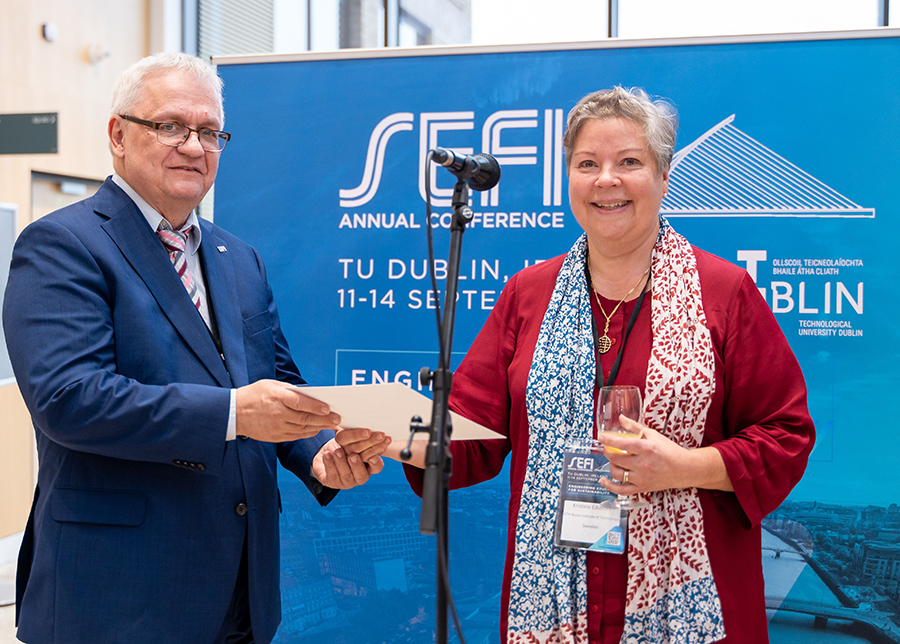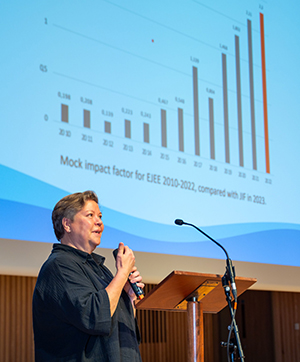Promoting excellence in engineering education: Kristina Edström made a Fellow of SEFI
At the annual SEFI conference Kristina Edström received the SEFI Fellowship Award.

Kristina Edström Associate Professor at the Department of Learning in Engineering Sciences at the KTH Royal Institute of Technology has been recognised for her outstanding contribution to engineering education by being named a Fellow of the European Society for Engineering Education (SEFI).
European Society for Engineering Education (SEFI)
The European Society for Engineering Education (SEFI) has been at the forefront of advancing engineering education since its inception in 1973 when KTH was one of 26 founders. Now SEFI is the largest network of engineering education institutions and educators in Europe. The SEFI Fellowship Award recognises significant contributions to engineering education in Europe. The recipients may add the title "Fellow of SEFI" to their names.
Kristina Edström on SEFI Fellowship
She shares her insights, experiences, and vision for engineering education in this interview. Join us as we explore her remarkable journey and aspirations.
Congratulations on receiving the SEFI fellowship!
How do you feel about this international recognition of your contributions to engineering education?
I’m delighted because the SEFI Fellowship is awarded for “meritorious service to engineering education in Europe.” I have been working on strengthening the international field of engineering education research.
You have been Editor-in-Chief of SEFI’s European Journal for Engineering Education for almost 6 years now. Could you share some insights into your work?
It started with a baptism of fire. When I applied to become editor-in-chief, I had seen the severe delays from the author's side and knew that the journal was in deep trouble. It could no longer be a one-man show, so I started by engaging two Deputy Editors. A mess of almost 300 manuscripts waited for us, some were 3 years old. It took many months of effort to reach a healthy steady state, but we did it together. Not only do many hands make light work, but it is so much more stimulating to work and think together. By now we also have a dozen Associate Editors, and the journal is thriving. So my best move has been to create a team of dedicated people.
What I enjoy most as an editor is that a journal has the power to shape a field, by selecting what work gets highlighted by publication. Early on, we formulated the aim that papers in EJEE should be both scholarly and useful for improving engineering education. This ideal resonates with the community. Many are engineers, and they are interested in improving education, not just studying it. The SEFI community feels ownership and pride in its flagship journal, with global authorship and readership.
What is the worst part of being an editor?
Rejecting valuable work! Since we accept 20-25%, a big part of my job is to convey sad news to authors. It hurts because some of the manuscripts that do not make it are still original and interesting to read, and they represent work that should be encouraged, and authors who deserve recognition. But now – and here comes breaking news – SEFI is starting a sister journal for precisely such papers, SEFI Journal of Engineering Education Advancement. It will be open access with a modest publication fee. I hope it will reduce authors’ need to use predatory journals.

You are also one of the organisers of the SEFI doctoral symposium. Why is it important to nurture the next generation of engineering education researchers?
Engineering education research is a new field. Many PhD supervisors are educational champions with a background in engineering subjects, but not trained in educational research themselves. PhD students need to know the leading scholars. Also, when a PhD student is alone in their university working on this topic, a supportive network means a lot. Last week in Dublin, we had 38 PhD students spending an intensive day with 23 top seniors of the field. Some start out a bit starstruck in the morning, but the open and welcoming atmosphere is tangible. One of the students said that he felt like an “oddball” at home, but now he had found his community. Everyone understood immediately what he meant.
During six years as an organiser, it has been wonderful to see people develop. Two of last week’s seniors started out as PhD delegates some years ago. The lead author of the topmost cited paper in EJEE is another former PhD delegate. And we knew them before they became famous!
CDIO (Conceive Design Implement Operate)
In the prize nomination you are called one of the driving forces of CDIO. How do you see CDIO continuing to evolve and impact engineering education in the future?
Ever since KTH started CDIO with MIT, Chalmers, and Linköping University, CDIO has been a significant force for improving engineering education. For twenty years now, the community has stayed vibrant with a perfect mix of newcomers and old pioneers like the KTH people, so it continues to be influential.
Recently, Anders Rosén and I have taken leading roles in updating the CDIO framework with sustainability as a main driver. This invites many universities worldwide to step up. Like in every academic community, however, we need to rethink our own travel. In my view, it would be easy to move every second CDIO conference fully online.
Your work with the Dutch 4TU Center for Engineering Education is also mentioned?
That is such an inspiring case. Each of the four technical universities had relatively small groups working on innovation and research in engineering education. Through a close national collaboration, they are now one of the strongest environments in Europe. It has also strengthened the groups at each university, with impressive work going on. I have led the Advisory Board since 2014 and am extremely proud of what we have achieved. We can create a similar model in Sweden or even better on the Nordic level.
Jan Van de Veen gave the Laudatio speech for Kristina Edström, and ended with this:
“What stands out is a passion for high-quality engineering education that can make a difference. Also, the notion that we need to work together to achieve this through meeting and sharing ideas and findings in ways meaningful for teachers and students. You are aware of the need to engage with newcomers and to invest in the new generation. Last but not least, it’s always fun to work with you. We highly appreciate that you are a champion in the engineering education community.”
Photo: Conor Mulhern, EyeOn.

